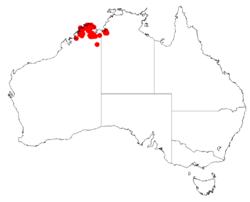Biology:Acacia kelleri
| Acacia kelleri | |
|---|---|
| Scientific classification | |
| Kingdom: | Plantae |
| Clade: | Tracheophytes |
| Clade: | Angiosperms |
| Clade: | Eudicots |
| Clade: | Rosids |
| Order: | Fabales |
| Family: | Fabaceae |
| Subfamily: | Caesalpinioideae |
| Clade: | Mimosoid clade |
| Genus: | Acacia |
| Species: | A. kelleri
|
| Binomial name | |
| Acacia kelleri F.Muell.
| |

| |
| Occurrence data from AVH | |
Acacia kelleri is a shrub or tree belonging to the genus Acacia and the subgenus Juliflorae that is endemic to north western Australia.
Description
The shrub or tree is openly branched, slender and often weeping, it typically grows to a height of 1.5 to 7 metres (5 to 23 ft)[1] and has fissured grey coloured bark. The light to dark brown branchlets are terete and woolly. The crowded and erect phyllodes have a linear to narrowly lanceolate shape. the phyllodes are straight to slightly curved and 1 to 2.5 centimetres (0.39 to 0.98 in) in length with a width of 0.7 to 2.5 millimetres (0.028 to 0.098 in).[2] It blooms from March to October producing yellow flowers.[1] The densely covered flower spikes are 1.3 to 4.5 cm (0.51 to 1.77 in) in length. Following flowering red brown seed pods for that are up to 11 cm (4 in) in length and 4.5 to 6 mm (0.177 to 0.236 in) long.[2]
Taxonomy
The plant was first formally described by the botanist Ferdinand von Mueller in 1892 as part of the work Observations on plants, collected during Mr Joseph Bradshaw's expedition to the Prince Regent's river published in Proceedings of the Linnean Society of New South Wales. The species was reclassified as Racosperma kelleri in 2003 by Leslie Pedley then transferred back to the genus Acacia in 2006.[3]
The type specimen was collected by Joseph Bradshaw in 1891 near Prince Regent River.[2]
Distribution
It is native to an area in the Northern Territory and the Kimberley region of Western Australia where it is found on rocky escarpments and stony creek beds growing in skeletal soils over sandstone.[1]
See also
References
- ↑ 1.0 1.1 1.2 "Acacia kelleri". FloraBase. Western Australian Government Department of Parks and Wildlife. https://florabase.dpaw.wa.gov.au/browse/profile/3398.
- ↑ 2.0 2.1 2.2 "Acacia kelleri". World Wide Wattle. CSIRO. http://worldwidewattle.com/speciesgallery/kelleri.php?id=3398. Retrieved 20 September 2018.
- ↑ "Acacia kelleri F.Muell.". Atlas of Living Australia. Global Biodiversity Information Facility. 20 September 2018. https://bie.ala.org.au/species/http://id.biodiversity.org.au/node/apni/2918716#names.
Wikidata ☰ Q9565840 entry
 |

